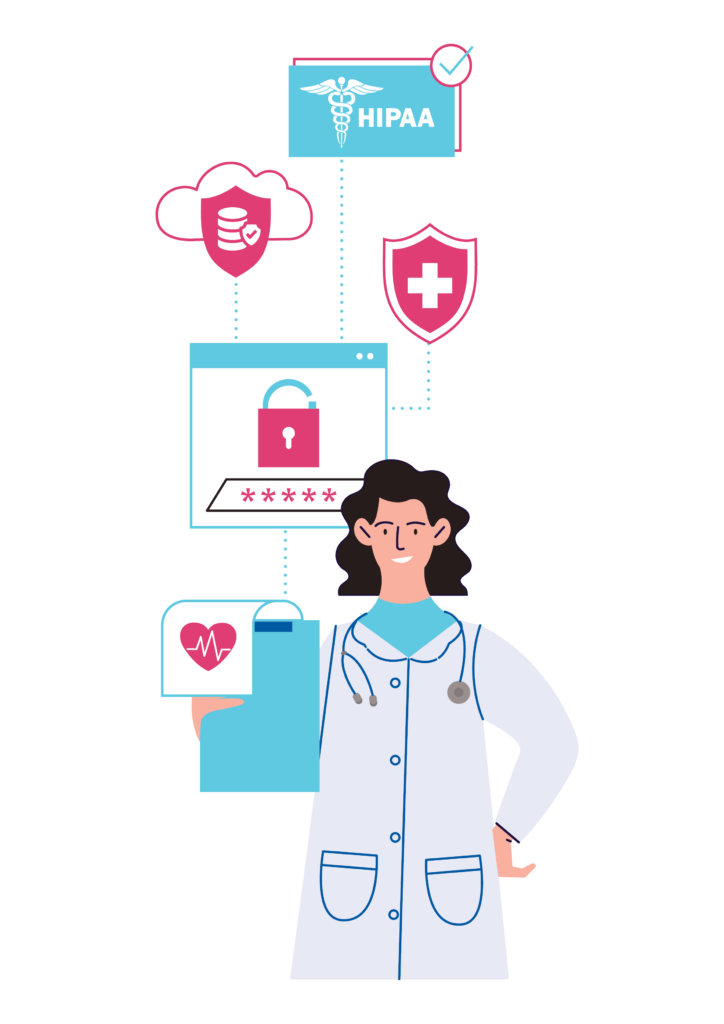If you’re subject to HIPAA compliance, navigating the different rules and regulations can feel like a daunting task — especially without a roadmap guiding you along the way. However, the only thing scarier than taking on HIPAA compliance alone is not taking it on at all.
Needless to say, HIPAA has a reputation for stressing people out, and rightfully so – it’s a federal law set out to protect critical health information in a landscape prone to breaches, threats, and data risks. Unfortunately, due to its criticality, complex rules, and severe penalties and fines, most businesses approach HIPAA compliance with a sense of urgency, caution, and dread.
So, to help ease the burden, here are our top 10 handy HIPAA hacks to help you stay compliant while protecting your patients and your business from the legal and financial consequences of a breach. But first, let’s do a quick refresher on the basics.
What is protected health information (PHI)?
At the very crux of everything HIPAA-related lies the holy grail – protected health information (PHI). HIPAA sets out to do everything in the name of PHI and how to best protect and manage it in an ever growing threat landscape. But what is PHI exactly? PHI refers to any individually identifiable health information.
Some examples of PHI include medical histories, insurance information, test results, payment information, and demographic data. So, in a nutshell, if your business comes in contact with any information that relates to a person’s healthcare, treatment, or coverage – it’s PHI, and it’s protected under the HIPAA law.
GET COMPLIANT 90% FASTER WITH AUTOMATION
Who needs to be HIPAA compliant?
The Privacy Rule determines mandatory HIPAA compliance. This rule confirms who needs to be HIPAA compliant and splits them into two main categories: covered entities (CEs) and business associates (BAs).
The scope for CEs includes healthcare providers, healthcare plan providers, and healthcare clearinghouses. Business associates include all organizations that work with covered entities and have direct or indirect exposure to PHI. This includes clearing houses, attorneys, shredding services, and more. If your business, regardless of size, falls into one of these categories, tag — you’re it. But what exactly does it mean?
What is HIPAA compliance?
The short of it? The Health Insurance Portability and Accountability Act (HIPAA) is a federal law that dictates how CEs and BAs are required to obtain, handle, and store protected health information (PHI). Being HIPAA compliant means that your company has implemented the standards for data protection determined by the HIPAA rules.
Within the HIPAA landscape, there are many avenues worth exploring, like who needs to be compliant, different types of HIPAA violations and penalties, the cost of HIPAA compliance, and the various rules (and which ones apply to you).
10 tips for HIPAA compliance
Considering HIPAA compliance’s complexities (and importance), here are our 10 tips to ensure you’re on the right track.
Tip 1: Don’t rely on your password-only authentication
As remote workspaces become more of a norm than a novelty, basic password protection will no longer suffice to protect data. One of the leading causes behind breaches is a failure to secure all of your remote access to data properly.
Instead of simply securing data by providing employees with unique usernames and passwords, consider layering up the authentication process with other secure access and authentication controls. One example can be implementing a strong password and username combined with a one-time password or security token.
Tip 2: Carefully review and evaluate your security awareness program
Although annual security awareness training programs are mandatory, not all training programs are created equal. Therefore, it’s critical that you carefully review and assess a security training program before implementing it.
The right security awareness training program should promote a behavioral change and test your employees’ comprehension of the covered topics and their ability to apply their knowledge to practical situations and real-life scenarios within their daily responsibilities. A few key questions to consider when choosing a security training program include:
- Does it include awareness campaigns?
- Are the training topics relevant to your organization, aligned with your security policies, and relevant to the employee’s job description and task scope?
- Does the training program offer various learning methodologies for a diverse group of employees?
- Does it include simulated exercises for employees to get familiar with what systems and response protocols to follow during a potential data breach?
Tip 3: Monitor social media use
Technically, HIPAA doesn’t say anything explicit about how to govern social media use. However, that doesn’t mean that it isn’t important. The governing HIPAA principles were created before the rise of social media, which means that for many businesses it can be a significant blindspot in terms of compliance — especially considering that social media is still subject to the Privacy Rule.
In a nutshell, organizations subject to HIPAA compliance may not publish or share any protected health information via social media, regardless of the format or platform (unless they have received written authorization to do so). However, there is a lesser-known but equally dangerous threat within the social media landscape: online feedback and reviews.
Businesses must take extra caution when responding to queries, reviews, or feedback in the public domain. Guard your PHI, even when the interaction seems insignificant. A good example of social media gone wrong is a 2022 case where the HHS Office for Civil Rights issued a $50,000 fine against a dental practice for using a patient’s full name in response to a complaint on the company’s Google business page.
Tip 4: Double-check your email provider
That’s right, trusted old Gmail and Outlook aren’t HIPAA compliant straight out of the box. To ensure consistent HIPAA compliance, businesses need to check for any gaps within their client communication system.
Unfortunately, most companies view email compliance as simply not sharing information with the wrong entities or keeping a close eye on phishing attacks. But, as with all things compliance, that’s only the tip of the iceberg. Be sure to invest in encrypted and HIPAA-compliant customer email providers to minimize the risk of leaking any protected information without even knowing it. Also, ensure that your employees are trained in using these secure email providers.
Tip 5: Keep software updated
How often have you ignored those pesky update requests that pop up when starting your device? You may be happy with your current software version, but that’s not the point. Sure, you may be compliant today, but tomorrow? Different story. Updating software is critical to staying compliant and keeps cybercriminals from exploiting any possible vulnerabilities.
HIPAA’s Security Rule sets out distinct requirements for all software and digital tools that come into contact with ePHI. However, as technology evolves and some versions are retired, older versions may no longer comply with the standards set by the Security Rule. So, how do you know whether or not it’s time to update your software? Regularly check for updates and ensure that your software is up-to-date to maintain compliance.
Generally, software support will notify users when it’s time for a periodic update. As software engineers discover weaknesses, patches are developed and available for download.
However, some software companies announce an “end-of-support,” which means that the vendor no longer provides updates, bug fixes, or technical support, creating a significant vulnerability in terms of security risks. To ensure consistent compliance, businesses must either download and install patches as soon as they are available, opt-in for automatic updates, or switch to software that provides support and updates aligned with the changing HIPAA legislation.
Tip 6: Prepare for the worst
Do you know what to do in the event of a data breach? More often than not, businesses are unprepared to deal with a data breach and rarely stick to the incident response plan. As if a data breach isn’t bad enough, the actions that follow are critical and, if left to chance, could potentially worsen the impact of the violation.
So, be sure to prepare the entire team on the do’s and don’ts within the scope of your incident response plan. Panicking leads to more mistakes, which is why the correct procedure should be taught and practiced by all team members.
When creating your incident response plan, be sure to include contacting a digital forensic investigator, law enforcement, and your attorney so they can best advise you during the particular breach.
Tip 7: Use a self-audit tool
Self-audits are your organization’s way of assessing compliance with HIPAA rules and regulations. They are your primary way to gauge whether or not you’re compliant with the HIPAA regulations and rules your organization is subject to. Self-audits also stand as the only proof of your compliance, which is why they must be as diligent as possible.
Miss something critical in your self-audit? We’ve got two words for you: non-compliant.
As no certifying body confirms your compliance, you’ll have to rely on your self-audits and risk assessments to ensure you’re adequately safeguarding your PHI. That’s why it’s best recommended to invest in a self-audit tool kit that can help you address the full extent of HIPAA regulations.
Tip 8: Be sure to check your fax compliance
Yes, faxes are still a thing. As a healthcare provider, you may have to send specific information via fax. However, this can become a potential risk to your HIPAA compliance without the proper guidance. To ensure that your faxes are risk-free and HIPAA compliant, you can do a few things.
First, it’s crucial to always confirm that the fax number you’re sending is correct. Many organizations pre-program their fax systems with frequently used fax numbers to minimize the risk of sending them to the wrong number. Additional safeguards may be storing your fax machine in a secure location and securely filing and disposing of faxes according to HIPAA guidelines. Implement a process for verifying the accuracy of fax numbers before sending sensitive information.
Tip 9: Document everything
They say the proof is in the pudding, and in the world of HIPAA compliance, “pudding” most definitely refers to all things policies and procedures. To ensure consistent HIPAA compliance, it’s best practice to document any assessments, guidelines, or policies relevant to your information security management.
Even if it’s not crucial in the present moment, in the event of an audit, documenting all actions may help prove that your organization has implemented due diligence, decreasing the consequences of a breach.
Tip 10: Automate the compliance process
Did you know that following a DIY approach to compliance can actually end up being more expensive in the long run? Many small businesses take on the compliance journey all by themselves.
However, due to the resource-intensive nature of compliance, it often costs them valuable time, resources, staff, and additional third-party fees. Even then, the process is still prone to error as risks slip through the cracks. Why? Well, staying up to date with changing legislation, monitoring all security controls 24/7, and managing day-to-day tasks is nearly impossible.
That’s why our top tip is to consider reviewing the right automated compliance tool that can help you manage all aspects of compliance on auto-pilot.
Ultimately, the most important tip to keep in mind is that there’s no need to take on the task of staying compliant all by yourself. Fortunately, finding partners in compliance may be easier than you think.
Your clients trust you with their most confidential conversations — we’ll help you keep them safe.










